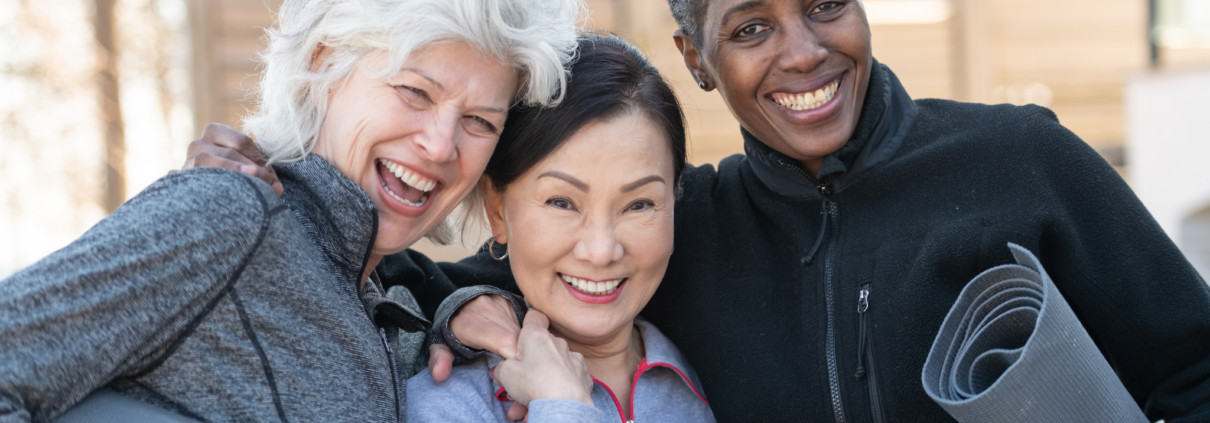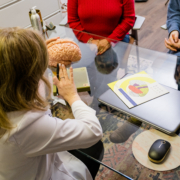When age is really just a number
We all age. Some of us age better than others. This is an area of expertise for Dr. Emily Rogalski, professor of neurology at the University of Chicago. Dr. Rogalski heads the school’s brand-new Healthy Aging & Alzheimer’s Research Care (HAARC) Center, which will focus on building deep multidisciplinary expertise and bridging the gap between scientific disciplines to accelerate breakthroughs in cognitive resilience. This focus is increasingly important as the world’s population continues to age—the World Health Organization estimates that one in six people will be aged 60 years or older by 2030. Early in her career, while at Northwestern University, Rogalski operationalized the term “SuperAger” to describe people over the age of 80 whose memory still functions as well as that of someone in their 50s or 60s. That project has received considerable attention, including this piece from CNN. The project also received a $20 million from the National Institute on Aging and the McKnight Brain Research Foundation to establish an international multi-center SuperAging Consortium. BrainWise Managing Editor Matt Villano caught up with Dr. Rogalski before a talk at the recent NAN Conference in Philadelphia to discuss her work, its implications, and where SuperAger research goes from here. What follows is an edited transcript of their chat.
BrainWise: How did you get into this area of neuropsychology?
Dr. Emily Rogalski: I grew up the daughter of a schoolteacher who taught kids with learning challenges. From a very early age I was surrounded by brilliant kids that learned a little bit differently. That’s really where my interest in the brain came from. As a young kid, I had a very naive question: ‘If these kids are so brilliant but they can’t learn in the traditional way that our schools are set up, I wonder if there’s something different about their brains.’ I think I’ve been always attracted by things that are on the outskirts rather than in the main lane, and how those elements can inform both the mainstream, but also help those on the outside. When I was in graduate school, I learned about a really rare dementia called Primary Progressive Aphasia (PPA), where instead of losing memory like we lose in Alzheimer’s dementia, individuals lose language. And not only that, but they lose it at a really young age. They can be in their 50s and 60s, even [in their] 40s sometimes. When this is happening, nobody is thinking it’s dementia. It can take years to get a diagnosis. I was really struck by the lack of research that was going on 20 years ago in this space and thought, ‘This is a real opportunity to explore and help.’ This dementia can be caused by Alzheimer’s disease about 40 percent of the time. And so I found myself in an aging and Alzheimer’s center for my dissertation work.
In the trajectory of aging, you’re constantly told there’s nowhere to go but down. Normally, the first thing that’ll come out of the mouth of anyone who’s giving an aging talk is something like, ‘As we get older, we lose our memory.’ [We’re taught to know] that when you get older, your eyesight changes, your hair gets gray, your skin gets wrinkled, and your memory declines. And while that makes sense in general, I think if we all stop to think about that, it’s not in practice all of the time. We all know the Betty Whites of the world. We know these people who really stick out as being something different. We know them as our neighbors, we know them as our aunts and uncles in our daily lives. And so this thing that we talk about with aging and it being nothing but bad news doesn’t really fit with people’s lived experience of they know at least somebody in this other sphere.
The challenge was that 15 years ago, there were people already studying successful aging. I think that was a great change in something that really [John] Rowe and [Robert Louis] Kahn did a great job of getting that concept out there, that there could be another trajectory called successful aging. But that definition and that concept was general. There was a great review done by [Colin] Depp and [Dilip] Jeste [in 2006] and they looked at definitions of successful aging. What they found was that in 28 studies, there were 29 different definitions. In and of itself, that’s not a problem. They also found that in those studies, the percentage of people who met the criteria for successful aging ranged from 0.9 percent to something like 97 percent. So virtually nobody to virtually everybody. That proved the definitions for successful aging were all over the place. One was you’re over the age of 65, dementia free, and you have good physical health. Another definition was that if you’ve lived to age 90, you’re a successful ager. There also were definitions in between—sometimes requiring good cognition, sometimes requiring good physical health. I started looking into aging and what makes for ‘successful’ aging. That’s when I [coined the phrase], SuperAgers.
BrainWise: What characterizes a SuperAger?
Dr. Rogalski: I operationalized this term SuperAger so it would be very specific. [The paper that established the definition is here.] While it fits under the larger umbrella of a type of successful aging, the goal was really to say we wanted to have both a specific neuropsychological definition and an age criteria. SuperAgers are individuals who are over age 80 who have memory performance at least as good as individuals in their 50s and 60s. Why age 80? Again, kind of back to this idea is everything gets worse when you’re older. And it turns out that merely getting older is the biggest risk factor for Alzheimer’s dementia. It wins. It wins over all other factors right now. By age 80, you’ve reached a point where you’re at great risk for typical or average cognitive decline. You’re at greater risk for Alzheimer’s dementia. If you’ve reached this age and then you have memory performance that’s youthful, that’s unique. If you’ve gone through all of those lived experiences, all that wear and tear, and you’re able to really look like a 50- to 60-year-old, that is, neuropsychologically speaking, quite different.
BrainWise: So, neuropsychologically speaking, what do all SuperAgers have in common?
Dr. Rogalski: We require them to have this memory performance that’s at least as good as 50- to 60-year-olds. Then we say other cognitive domains have to be at least average, but we’re going to explore it and then we’re going to look at those as variables to say, well, how much does attention and executive function contribute? When Dr. Amanda Cook Mayer was a graduate student at Northwestern working with me (now she’s faculty at the University of Michigan), we did a study on that to say, what are their other strengths in cognitive function? What we found is there’s not one path to get there, but [SuperAgers] tend to have strengths in attention and executive function, and that there’s some variability that helps to explain some of their memory performance. Some SuperAgers, no matter which cognitive tests you give them, knock it out of the park. They perform like 50- to 60-year-olds or better across all the cognitive domains. In other instances, there’s people where memory is really their strength and other cognitive domains are average. There’s a third trajectory where people of course have great memory, and the other cognitive domains oscillate a little bit. I think this is important because it’s not that the SuperAgers had to get there all the same way. There can be different paths or trajectories that got them here. As we move more toward personalized medicine and precision health, we have an opportunity to understand the contributors to each of those pathways.
BrainWise: How does this translate to your current study?
Dr. Rogalski: Our goal in this study is not to just look at one domain. So some studies are like, ‘I’m a study of sleep.’ That’s very important, but that’s not what we are going for. We really wanted to cover as many domains as possible, do them well, and then look for that integration across the things. So we’re going to look at structural function, but how does that relate to cognitive function? We’re going to look at genetic factors. What’s the interplay between cognition, genetics, neuropathology, and brain structure? What can we detect during life, knowing that in a living person, we can only see with a certain resolution? I liken this to when we first got digital cameras and we were all excited, we didn’t need film anymore, and we could take a bunch of pictures and that seemed great and they looked great on the back of our cameras. And then we printed them out in our home printers, and everybody’s faces looked like little squares. They were pixelated. Well, that’s about the resolution we can see during life. And so this is where someone donating their brain at the time of death gives us that better resolution where we’re at with our iPhones now or better so that we can really look at contributors of cellular and molecular factors.
BrainWise: Can you give us specifics about one of your SuperAgers?
Dr. Rogalski: Our oldest SuperAger is 109. And I was at her house a couple of weeks before her birthday to bring her a present, and we did a little video shoot with her. The day before, she made us strawberry rhubarb jam. She’d never made strawberry rhubarb jam before. She’s still trying new recipes at age 109, and it was delicious. She enrolled [in the SuperAger study] when she was in her early 100s. At that time, she was driving, and I would’ve ridden in the car with her. She only stopped driving because she got gout, and the medicine she was taking messed with her grip strength. She’s sharp as a tack. We ended up doing a three-hour interview [with her]. Her best quotes were at the end of the interview. I mean, everybody was in tears as she was sharing aspects of her life. She was the first Black woman to graduate from Grinnell College in Iowa. She talked about the first time there was a radio in her house, the first time there was a phone. Think about what she’s lived through: two pandemics, World War I, [World War II]. That’s pretty remarkable. She’s seen a lot.
BrainWise: How many people over 100 are participating in the study?
Dr. Rogalski: Fewer than 10, out of about 300 total.
BrainWise: How do I know if I’m a SuperAger, and what can I do to increase my chances to become one?
Dr. Rogalski: We know that diet and exercise are important from [epidemiologic] studies and from other cohort studies. When we look at SuperAgers specifically, we see they have variable diet and exercise. The good news [there] is [that] it’s a good idea to pay attention to your diet and exercise, but all may not be lost if you’ve not paid the closest attention.
We know that SuperAgers range in education from 12 to 20 years. So it’s not just doctors and lawyers that we’ve enrolled. And every time we make a comparison in our study, the IQ of the control group is always in the same range. So that means it’s not just general intelligence or a measure of intelligence that’s differentiating the groups. I’ve worked with cohorts in South America where they have focused on enrolling or identifying SuperAgers that have little to no education, and they’ve been able to find them. We [too] are starting to enroll more diverse samples. It is possible to find SuperAgers who have lower education. We’re not just picking up on extreme levels of education that allow you to maintain good cognition over age 80.
I think one practical thing that we’ve seen, and now we’re trying to quantify it more objectively, is that SuperAgers report having stronger social relationships with others. We don’t know much about those relationships. We don’t know whether they have one best friend that’s a trusted partner, or if they are the social butterflies of their community. I know anecdotally many of them are the social butterflies of their communities.
Until recently all the data we collected on SuperAgers was self-reported. Then in 2020 we had this opportunity to write a grant that expanded the program to make it multi-site and to change the depth and breadth of science that we do. And one of the ways that we changed the depth and breadth of science was to add in wearable sensors. Now we ask the SuperAgers to wear these in their daily lives for about 14 days so we can get measurements of activity and social engagement. Objectively we can get measures of sleep and autonomic function. For all the survey data and the anecdotes that we have collected over the first 15 years, we’re now collecting those data objectively and quantitatively moving forward across five cities in the U.S. and Canada.
BrainWise: To what extent could a SuperAger potentially have issues with eyesight or have some physical disability, and where does that come into play with your research?
Dr. Rogalski: I was very intentional in not requiring super agers to have good physical health. We know from the larger body of research that good physical health tends to be associated with good cognitive health. And this makes sense for a lot of reasons. However, if you make that an entry barrier, now you’re kind of penalizing people who were able to maintain great cognitive health, but they might need a wheelchair or a walker. Their physical aging or their physical brain age may outpace their cognitive brain age, and I didn’t want to have that penalty. Instead, I wanted to be able to look and say, ‘How many people do we find that are using wheelchairs or walkers?’ So our SuperAgers vary. Some of them are riding their bikes hundreds of miles a week or in the pool doing exercises and weightlifting in the pool. Others are leading a chair stretching class. There also are several who are like, ‘I don’t exercise and I don’t plan to start exercising.’
What we do see in our super agers is that their brain integrity and brain structure looks different. They tend to look more like 50- to 60-year-olds in brain structure than they look like 80-year-olds. In this instance, we’re talking about cortical thickness. That’s the outer layer of your brain where your brain cells live—we can measure that thickness and it gives us a proxy measure of the health of the brain. Generally speaking, thinner is worse and thicker is better. When we compare our average 50-year olds to our average 80-year olds, we see that same thing that others have shown: cortical thinning across the cortex of the brain. When we compare our super agers to the average 50-year olds, we don’t see any significant cortical thinning. In fact, we see a region in the anterior cingulate cortex that’s thicker in super agers than it is in the 50-year olds. This has spurred some of our investigations pathologically to make sure we’re paying close attention to this anterior cingulate region.
BrainWise: Where do biomarkers fit into this research? At what point do you hope we can begin to apply some of these lessons you’ve learned to say 40- and 50-year-olds to maybe help them get a sense of whether or not they will become a SuperAger?
Dr. Rogalski: The larger body of research tells us social isolation and loneliness are bad. There are studies that have shown those who are socially engaged and have Alzheimer’s dementia tend to have slower trajectories of decline and tend to fare better cognitively. Our data fit with that. The practical implication is that if you’re going to go home today and on your commute home, you’re thinking about calling your best friend, call them, talk to them, stay socially engaged. Why might that be important from a brain health standpoint? Conversation is hard. I don’t know exactly what you’re going to say next, but you’re going to ask me a question. And then I have to think really quickly on my feet to say, ‘Okay, how am I going to answer that?’ Our brain likes new and challenging things, and social engagement creates that newness all the time to keep you on your toes, so to speak.
Finding the thicker anterior cingulate, that was serendipitous and it led us to other research questions. Under the microscope, it turns out we see a greater density of a special type of neuron called Von Economo neurons. These are neurons that have only been described in two regions of the brain, the anterior cingulate [cortex] and the frontal insular cortex. They seem to have something to do with social behaviors and social function, and they tend to be abnormal in Alzheimer’s dementia, frontotemporal dementia, autism, schizophrenia, bipolar disorder. They also tend to only be present in higher order species like [humans and] whales and elephants. We can now look cellularly, molecularly, genetically at these neurons to say, what role are they playing? This [part of our research] isn’t going to have an actionable endpoint tomorrow, but we need to be looking at all of these different levels. And so that’s kind of the beauty of the design that we have, is that some things kind of glean more actionable things to think about today, where others might lead to whole new directions and protective factors that might take a little bit longer to get there.
[To speak to the issue of biomarkers], we are looking at blood-based biomarkers. Some of the SuperAgers have been getting amyloid PET and tau PET scans so that we can measure aspects of Alzheimer’s disease during life, and then also measure it at the time of death when they pass away. As I’ve mentioned, one thing about SuperAgers is that they tend to be healthier, so I always joke that I do better in my side of the study that’s on the living side than my colleagues who have to wait until they pass away because they keep living.
BrainWise: Which questions will you be asking in your research next?
Dr. Rogalski: I lead what’s called the SuperAging Research Initiative, which now has five sites across the U.S. and Canada. My particular expertise is in the cognitive aspects, the neuroimaging aspects, and in some of the social function and other survey data that we give. My partners in this are geneticists, neuropathologists, neuroanatomists, [and others]. I’m kind of fluent in many of these things, but they’re the primary leaders, and that’s the goal, to bring together these scientists with these different expertise so that we can really dig a little bit deeper. And so now we’ve got these partners across the U.S. and Canada, and we’ve got the SuperAgers.
Another goal is to diversify our sample, make sure we’re identifying SuperAgers in different communities, both regionally across the U.S. and Canada, but also racially and ethnically. We’re working hard to make sure we’ve got strong community partnerships and trusted relationships, and we’re not just coming in and saying, ‘Sign up for research!’ We want to make sure we’re intentionally there and building partnerships because these folks are with us for life. When they sign up, they’re coming back year after year after year. It’s a relationship we’re starting with them. It’s not a study where they come in for one blood draw, and we never see them again. This is longer term.
This essay has been factchecked by members of NAN’s Publications Committee. For more about that process, click here.









